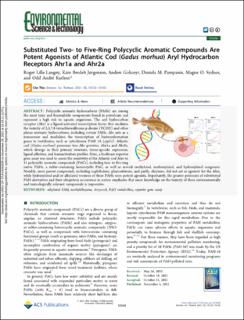Substituted Two- To Five-Ring Polycyclic Aromatic Compounds Are Potent Agonists of Atlantic Cod (Gadus morhua) Aryl Hydrocarbon Receptors Ahr1a and Ahr2a
Lille-Langøy, Roger; Jørgensen, Kåre Bredeli; Goksøyr, Anders; Pampanin, Daniela Maria; Sydnes, Magne Olav; Karlsen, Odd André
Journal article, Peer reviewed
Published version

Åpne
Permanent lenke
https://hdl.handle.net/11250/2832035Utgivelsesdato
2021Metadata
Vis full innførselSamlinger
- Department of Biological Sciences [2232]
- Registrations from Cristin [9766]
Originalversjon
Environmental Science and Technology. 2021, 55 (22), 15123-15135. 10.1021/acs.est.1c02946Sammendrag
Polycyclic aromatic hydrocarbons (PAHs) are among the most toxic and bioavailable components found in petroleum and represent a high risk to aquatic organisms. The aryl hydrocarbon receptor (Ahr) is a ligand-activated transcription factor that mediates the toxicity of 2,3,7,8-tetrachlorodibenzo-p-dioxin (TCDD) and other planar aromatic hydrocarbons, including certain PAHs. Ahr acts as a xenosensor and modulates the transcription of biotransformation genes in vertebrates, such as cytochrome P450 1A (cyp1a). Atlantic cod (Gadus morhua) possesses two Ahr proteins, Ahr1a and Ahr2a, which diverge in their primary structure, tissue-specific expression, ligand affinities, and transactivation profiles. Here, a luciferase reporter gene assay was used to assess the sensitivity of the Atlantic cod Ahrs to 31 polycyclic aromatic compounds (PACs), including two- to five-ring native PAHs, a sulfur-containing heterocyclic PAC, as well as several methylated, methoxylated, and hydroxylated congeners. Notably, most parent compounds, including naphthalene, phenanthrene, and partly, chrysene, did not act as agonists for the Ahrs, while hydroxylated and/or alkylated versions of these PAHs were potent agonists. Importantly, the greater potencies of substituted PAH derivatives and their ubiquitous occurrence in nature emphasize that more knowledge on the toxicity of these environmentally and toxicologically relevant compounds is imperative.
